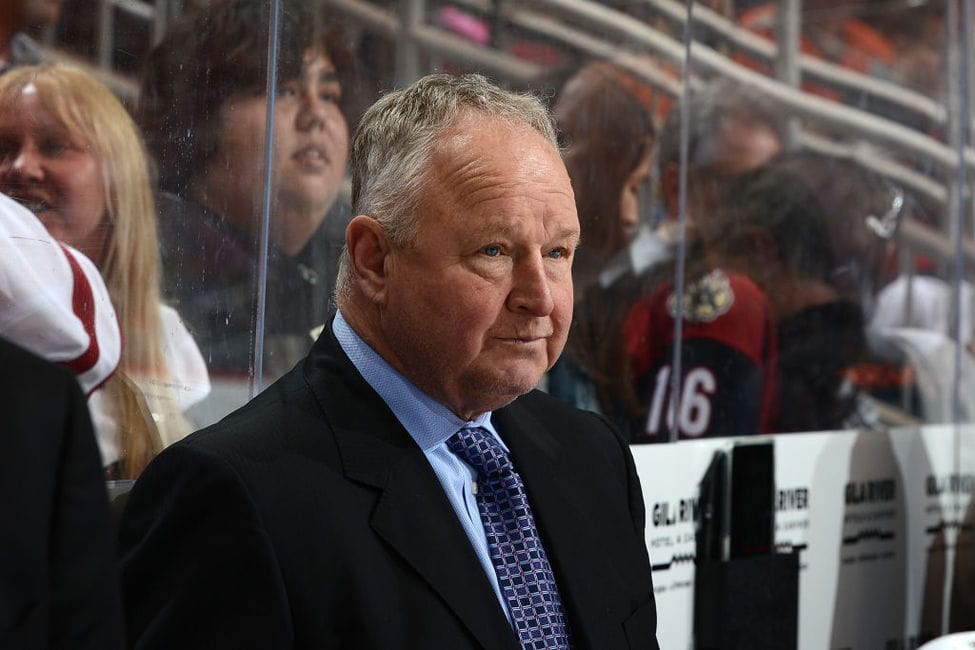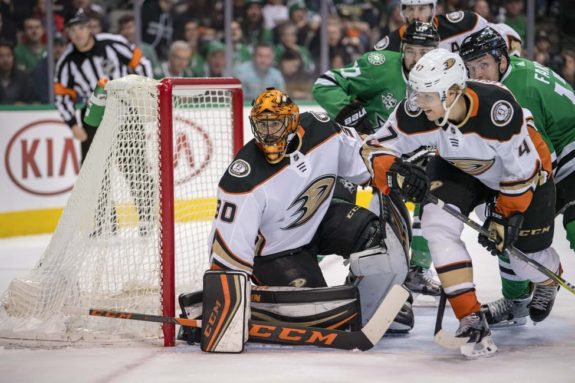
To start the 2018-19 NHL season, the Anaheim Ducks have accumulated nine points in six games. It’s their best start since the 2014-15 season and they lead the Pacific Division. One major problem persists, though — the Ducks are winning games in an unsustainable way.
Ducks head coach Randy Carlyle has seen his team struggle to generate offense but still win games. (Norm Hall/NHLI via Getty Images)
They’re the league’s worst team in Corsi-for percentage — although the number has improved — at 39.5 percent in 5-on-5 situations. The differential between shots for and those they’ve given up is enormous, meaning they’re still relying on goaltenders John Gibson and Ryan Miller to win games.
Advanced statistics indicate that the Ducks have overcome lop-sided performances, but why, exactly, is the team struggling to such a great extent in terms of puck possession and shots?
The Gibson Defense
The Ducks’ investment in Gibson looks pretty good as he’s already stolen a couple wins in this young season. In order to give him the best chance to succeed, Anaheim is focusing its defensive efforts on eliminating cross-ice passes which expose one of Gibson’s weaknesses, moving side-to-side.
In her article for The Athletic, goaltending guru Cat Silverman explains what exactly that entails:
“Rather than limiting shots in even their good games, they limit passing opportunities for the other team. As explained by Arizona Coyotes head coach Rick Tocchet following their two-game series this past week, the Anaheim blueline does an excellent job of “choking up on those lanes” — which may make it easier to get off those initial shots, but incredibly difficult to draw Gibson out and get him off balance with a cross-ice pass,” (from ‘Behind the Save: How Anaheim’s defensive system can make or break John Gibson: The Athletic NHL – 10/14/18).
Silverman goes on to highlight the Ducks’ emphasis on clogging up the middle of the ice, between the hash marks and Gibson’s crease. Theoretically, this works well, but there’s a chain reaction that follows this strategy, besides forcing Gibson to face an unholy amount of rubber.
In order to effectively clog “The Royal Road,” or the area from the middle of the crease to center ice, players must be bunched closer together. Once the shot from the point is made, it is often deflected into the corners. With players bunched in the middle of the defensive zone, it’s much harder to win foot races into the corners to pounce on loose pucks. The Ducks defenders have had extreme difficulty getting to those loose pucks and when they do get there, they’ve often lost the puck battle. This has limited their ability to breakout.
Rookies and the Breakout
One of the most crucial aspects of puck possession and generating offense is a clean breakout. If you turn over the puck at the blue line with an errant breakout pass or a failed clearing attempt your opponent is likely to generate a shot attempt. An inaccurate breakout pass, even if it’s caught, can force a player to dump the puck instead of maintaining possession into the offensive zone. This has been a major struggle for Anaheim so far this season. As much as it’s tough to admit, this is partially due to inexperience.
Randy Carlyle has no choice but to play rookies as a result of injuries to Ryan Getzlaf, Ondrej Kase, Corey Perry and now Carter Rowney and Jakob Silfverberg. He’s given Max Comtois first-line minutes and formed his entire third line — affectionately referred to as the “kid line” by analyst Brian Hayward — with rookies.
On offense, the Ducks’ collection of first-year players has largely been a success. A rookie has contributed at least a point in every game so far but one. Defensively, however, they’ve had some hiccups; most notably with breaking the puck out of the zone. This includes Comtois, the golden boy, who was slow to react on a breakout Sunday against the St. Louis Blues.
As you can see in the replay, Comtois turns the puck over when he fails to notice Blues defender Joel Edmundson stepping up on him from the point. This results in a chance by Vladimir Tarasenko and then the eventual goal after Alex Steen tips a shot from Edmundson.
Comtois isn’t alone. A few of the Ducks’ rookie forwards have struggled defensively. This is understandable since inexperience tends to manifest itself in the defensive zone first. Since breaking the puck out successfully is a key factor in puck possession, it’s no surprise that individual Corsi-for percentages among some of the Ducks’ rookies are very low. Along with Troy Terry and Sam Steel, Comtois has one of the team’s lowest 5-on-5 Corsi-for percentages at 34.2 percent.
Steel’s case is the most interesting as he’s played with Kiefer Sherwood and Isac Lundestrom who rank two and three behind Brian Gibbons at 5-on-5 Corsi-for percentage, yet he is just a tick above Comtois at 34.6 percent.
The upside to this crash course in NHL hockey for the Ducks’ rookies is that hopefully, they will improve their defensive play more rapidly. In addition, the imminent return of Getzlaf and the continuing recovery of Patrick Eaves my give Anaheim some relief.
Win Faceoffs in Front of Gibson and Miller
The Ducks are struggling in a big way on faceoffs. They rank 29th in win percentage at 44.1 percent of faceoffs won. On a game-by-game basis, this season the Ducks have not won more than 50 percent of faceoffs against their opponents and in Sunday’s game against the Blues, they only won 35 percent.

Ducks goalie Ryan Miller watches a puck in the corner.
With the Ducks struggling to win battles in the defensive zone, struggling to break the puck out cleanly and struggling to generate sustained offense, winning faceoffs would go a long way.
You Can’t Win 0-0
Somehow, in spite of all of this, the Ducks are still winning. With such minuscule puck possession numbers, how are they scoring enough to win, even with Gibson’s heroic efforts? The Ducks are tied for ninth in the league in goals for, yet they rank 23 in shots. One explanation is that they are very opportunistic. They are scoring on 11.19 percent of their shots in all situations. They drop two spots to twelfth in the league in 5-on-5 situations.
Another answer would be their efficiency on the power play. Of the team’s 17 goals scored, four have come on the man advantage. That’s not to say the power play has been lights out. They rank 10th in the league in power play percentage, but when they do get shots, they score on almost one-third of them.
PD-“Oh No”
So far, this opportunistic style of play has worked out, but it’s hard to say for how long. If you believe in the advanced stat PDO the situation looks bleak. PDO is calculated by taking the sum of a team’s shooting percentage and save percentage. The Ducks’ decent 5-on-5 shooting percentage this season combined with Gibson and Miller’s stellar save percentage yields a PDO of 105, good for second in the league.
Since the PDO number naturally tends to come back to 100, anything over that is considered good; 105 is very high. By comparison, the team with the league’s best PDO number last season was the Tampa Bay Lightning at 102. This suggests that the Ducks’ goaltending or scoring efficiency is unsustainable. With the number of shots they give up each night, and the lack of offensive puck possession they’ve been able to achieve, it’s easy to imagine either regressing.
The team understands this. Assistant coach Marty Wilford said it best to Jill Painter Lopez between periods of the game against the Dallas Stars:
“The best way to contain them is make them play in their own end.”
So far for the Ducks, that is much easier said than done.
(All stats found at Hockey-Reference.com and naturalstattrick.com)
Be the first to comment